E.G. Wolverson's Blog, page 12
June 28, 2015
The Anti-Inflammatory Cookbook | Crispy Curly Kale
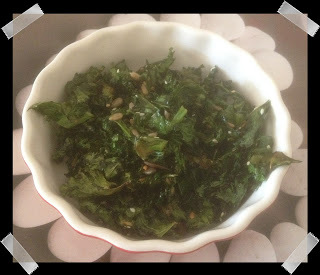 A natural source of vitamin-C that’s not an inflammatory orange or citrus fruit, kale has an important part to play in an anti-inflammatory diet.
A natural source of vitamin-C that’s not an inflammatory orange or citrus fruit, kale has an important part to play in an anti-inflammatory diet. The trouble is, it’s green – and that puts a lot of people off even tossing it in a smoothie. The looks of contempt that my spinach, carrot and kale concoctions draw from even my daughter – “Daddy… Why are you drinking that snot juice again?” – are staggering.
Give someone a portion of this, however, and they’ll never look at everyone’s least-favourite superfood the same way again…


100g curly kale [69p for 200g, so 35p]
35g crunchy trail seed mix [49p for 70g, so 25p]
2tbsp (30ml) extra virgin olive oil [£2.99 per 500ml, so 18p]
2 pinches of rock salt [£1.30 per 500g; cost is therefore de minimis]
TOTAL COST TO MAKE TWO PORTIONS £0.35 + £0.25 + £0.18 = £0.78
TOTAL COST PER PORTION: £0.39

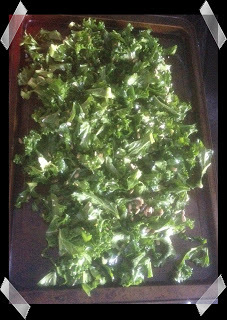
ONE
Pre-heat the oven to 180°c.
TWO
Place the kale in a mixing bowl and drizzle with the oil, adding a pinch or two of rock salt as required.
THREE
Mix in the seeds and then transfer the product to a baking tray.
FOUR
Roast in the oven until the kale has a crispy texture (usually after around 8-10 minutes). Once it looks done, remove it from the oven quickly or you risk burning it.
FIVE
Eat warm as a side-dish (it goes well in the place of seaweed with a Chinese dish) or bag it up as an alternative to inflammatory potato crisps.
Published on June 28, 2015 12:36
June 27, 2015
The Anti-Inflammatory Cookbook | Soya Protein Porridge
As I don’t eat meat but spend a lot of time in the gym, it’s incredibly important for me to eat a wide variety of other proteins. I wouldn’t recommend heavily-processed synthetic proteins such as mycoprotein (Quorn), but I do still champion pure whey isolate, provided that it’s devoid of sweeteners and other unnecessary ingredients, and it’s whey that forms the basis of one of my favourite breakfasts: protein porridge.
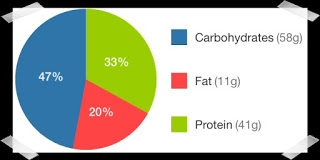
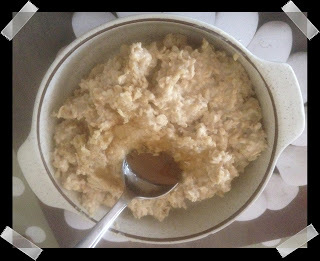 For the sake of a variety, though, every once in a while I mix things up with an almost vegan alternative. You’ll hear many criticise soya-derived proteins as being incomplete, or even feminising, but when enjoyed as part of a varied vegetarian diet I’ve never suffered any detrimental effects after consuming them– quite the opposite, in fact. Whether I’m using soya or whey for my post-workout shake, my gains seem to be similar. The same rule applies to my all-important, fast-breaking protein porridge – whether it’s made of soya or whey, it sets me up for the day with its near-perfect fusion of slow-burning, muscle-maintaining nutrients.
For the sake of a variety, though, every once in a while I mix things up with an almost vegan alternative. You’ll hear many criticise soya-derived proteins as being incomplete, or even feminising, but when enjoyed as part of a varied vegetarian diet I’ve never suffered any detrimental effects after consuming them– quite the opposite, in fact. Whether I’m using soya or whey for my post-workout shake, my gains seem to be similar. The same rule applies to my all-important, fast-breaking protein porridge – whether it’s made of soya or whey, it sets me up for the day with its near-perfect fusion of slow-burning, muscle-maintaining nutrients.
An important note for this recipe is that if you vary from the brands that I’ve specified, you risk using inflammatory ingredients. Nature’s Garden’s pure soya protein isolate powder is one of the few that I’ve found that’s genuinely free from sweeteners and preservatives; all it contains beyond the soya protein isolate is soya lecithin (as an emulsifier) and silicon dioxide (as an anti-caking agent). Thus far, Alpro’s organic unsweetened wholebean soya milk is the only commercial cows’ milk substitute that I’ve found that I can drink without suffering an arthritic flare-up. It contains just hulled soya beans and water; that’s it. As ever though, you pay more for less.

75g natural rolled oats [75p per 1kg, so 6p]
28g Nature’s Garden pure soya protein isolate powder [£19.19 for 908g, so 59p. Often cheaper, in fact, as it’s often on “Buy One, Get One Half Price” in Holland and Barrett]
15g clear honey [99p for 340g, so 4p]
250ml organic wholebean soya milk [£1.39 per 1l, so 35p]
TOTAL COST TO MAKE ONE BOWL: £0.06 + £0.59 + £0.04 + £0.35 = £1.04
TOTAL COST PER BOWL: £1.04


ONE
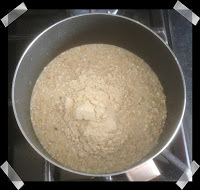 Put the oats in a saucepan before adding the soya milk and a level scoop (28g) of the protein powder. I’d recommend adding a pinch of rock salt and a little coconut oil too, though these aren’t accounted for in the nutritional information provided.
Put the oats in a saucepan before adding the soya milk and a level scoop (28g) of the protein powder. I’d recommend adding a pinch of rock salt and a little coconut oil too, though these aren’t accounted for in the nutritional information provided.
TWO
Bring to the boil and simmer for five minutes, stirring constantly to ensure that the mixture doesn’t stick to the bottom of the pan.
THREE
Pour into a bowl and add a spoonful of honey to sweeten.

 For the sake of a variety, though, every once in a while I mix things up with an almost vegan alternative. You’ll hear many criticise soya-derived proteins as being incomplete, or even feminising, but when enjoyed as part of a varied vegetarian diet I’ve never suffered any detrimental effects after consuming them– quite the opposite, in fact. Whether I’m using soya or whey for my post-workout shake, my gains seem to be similar. The same rule applies to my all-important, fast-breaking protein porridge – whether it’s made of soya or whey, it sets me up for the day with its near-perfect fusion of slow-burning, muscle-maintaining nutrients.
For the sake of a variety, though, every once in a while I mix things up with an almost vegan alternative. You’ll hear many criticise soya-derived proteins as being incomplete, or even feminising, but when enjoyed as part of a varied vegetarian diet I’ve never suffered any detrimental effects after consuming them– quite the opposite, in fact. Whether I’m using soya or whey for my post-workout shake, my gains seem to be similar. The same rule applies to my all-important, fast-breaking protein porridge – whether it’s made of soya or whey, it sets me up for the day with its near-perfect fusion of slow-burning, muscle-maintaining nutrients.An important note for this recipe is that if you vary from the brands that I’ve specified, you risk using inflammatory ingredients. Nature’s Garden’s pure soya protein isolate powder is one of the few that I’ve found that’s genuinely free from sweeteners and preservatives; all it contains beyond the soya protein isolate is soya lecithin (as an emulsifier) and silicon dioxide (as an anti-caking agent). Thus far, Alpro’s organic unsweetened wholebean soya milk is the only commercial cows’ milk substitute that I’ve found that I can drink without suffering an arthritic flare-up. It contains just hulled soya beans and water; that’s it. As ever though, you pay more for less.

75g natural rolled oats [75p per 1kg, so 6p]
28g Nature’s Garden pure soya protein isolate powder [£19.19 for 908g, so 59p. Often cheaper, in fact, as it’s often on “Buy One, Get One Half Price” in Holland and Barrett]
15g clear honey [99p for 340g, so 4p]
250ml organic wholebean soya milk [£1.39 per 1l, so 35p]
TOTAL COST TO MAKE ONE BOWL: £0.06 + £0.59 + £0.04 + £0.35 = £1.04
TOTAL COST PER BOWL: £1.04


ONE
 Put the oats in a saucepan before adding the soya milk and a level scoop (28g) of the protein powder. I’d recommend adding a pinch of rock salt and a little coconut oil too, though these aren’t accounted for in the nutritional information provided.
Put the oats in a saucepan before adding the soya milk and a level scoop (28g) of the protein powder. I’d recommend adding a pinch of rock salt and a little coconut oil too, though these aren’t accounted for in the nutritional information provided.TWO
Bring to the boil and simmer for five minutes, stirring constantly to ensure that the mixture doesn’t stick to the bottom of the pan.
THREE
Pour into a bowl and add a spoonful of honey to sweeten.
Published on June 27, 2015 12:59
The Anti-Inflammatory Cookbook | £1 Soya Protein Porridge
As I don’t eat meat but spend a lot of time in the gym, it’s incredibly important for me to eat a wide variety of other proteins. I wouldn’t recommend heavily-processed synthetic proteins such as mycoprotein (Quorn), but I do still champion pure whey isolate, provided that it’s devoid of sweeteners and other unnecessary ingredients, and it’s whey that forms the basis of one of my favourite breakfasts: protein porridge.
 For the sake of a variety, though, every once in a while I mix things up with an almost vegan alternative. You’ll hear many criticise soya-derived proteins as being incomplete, or even feminising, but when enjoyed as part of a varied vegetarian diet I’ve never suffered any detrimental effects after consuming them– quite the opposite, in fact. Whether I’m using soya or whey for my post-workout shake, my gains seem to be similar. The same rule applies to my all-important, fast-breaking protein porridge – whether it’s made of soya or whey, it sets me up for the day with its near-perfect fusion of slow-burning, muscle-maintaining nutrients.
For the sake of a variety, though, every once in a while I mix things up with an almost vegan alternative. You’ll hear many criticise soya-derived proteins as being incomplete, or even feminising, but when enjoyed as part of a varied vegetarian diet I’ve never suffered any detrimental effects after consuming them– quite the opposite, in fact. Whether I’m using soya or whey for my post-workout shake, my gains seem to be similar. The same rule applies to my all-important, fast-breaking protein porridge – whether it’s made of soya or whey, it sets me up for the day with its near-perfect fusion of slow-burning, muscle-maintaining nutrients.An important note for this recipe is that if you vary from the brands that I’ve specified, you risk using inflammatory ingredients. Nature’s Garden’s pure soya protein isolate powder is one of the few that I’ve found that’s genuinely free from sweeteners and preservatives; all it contains beyond the soya protein isolate is soya lecithin (as an emulsifier) and silicon dioxide (as an anti-caking agent). Thus far, Alpro’s organic unsweetened wholebean soya milk is the only commercial cows’ milk substitute that I’ve found that I can drink without suffering an arthritic flare-up. It contains just hulled soya beans and water; that’s it. As ever though, you pay more for less.

75g natural rolled oats [75p per 1kg, so 6p)
28g Nature’s Garden pure soya protein isolate powder [£19.19 for 908g, so 59p. Often cheaper, in fact, as it’s often on “Buy One, Get One Half Price” in Holland and Barrett]
15g clear honey [99p for 340g, so 4p]
250ml organic wholebean soya milk [£1.39 per 1l, so 35p]
TOTAL COST TO MAKE ONE BATCH (620G): £0.06 + £0.59 + £0.04 + £0.35 = £1.04
TOTAL COST PER BOWL: £1.04


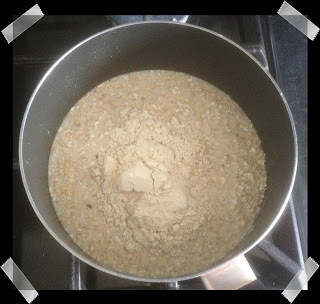 ONEPut the oats in a saucepan before adding the soya milk and a level scoop (28g) of the protein powder. I’d recommend adding a pinch of rock salt and a little coconut oil too, though these aren’t accounted for in the nutritional information provided.
ONEPut the oats in a saucepan before adding the soya milk and a level scoop (28g) of the protein powder. I’d recommend adding a pinch of rock salt and a little coconut oil too, though these aren’t accounted for in the nutritional information provided.TWOBring to the boil and simmer for five minutes, stirring constantly to ensure that the mixture doesn’t stick to the bottom of the pan.
TWOPour into a bowl and add a spoonful of honey to sweeten.
Published on June 27, 2015 12:59
June 23, 2015
First-hand Fitness #5 | On Diet: Controlling Arthritis with Food
I never noticed how many miracle cures were touted for the lurgy until I found out I had it. My particular ailment, psoriatic arthritis, falls under the general rheumatism / arthritis umbrella that, of late, every newspaper seems to think can be cured by everything from magnets to miracle jabs.
But the more I’ve read about nutrition, and the more I’ve experimented with it, the more I’ve come to believe that disease control by diet should be the first treatment tried. If you take the time to look for it, there is an overwhelming amount of anecdotal evidence in support of dietary approaches, yet not a single, in-depth academic study that I can trace (as you can imagine, pharmaceutical companies aren’t all that keen to throw money at studies likely to steer people away from their wares). Yet I’ve found that by following an “alternative” diet - eliminating, or at least reducing to the lowest level practicable, foods that are poisonous to my body, while embracing foods that serve as a natural medicine - I’ve completely halted the progression of the disease and all but eliminated symptoms in my already-damaged joints; they bend again and everything.
 Following an anti-inflammatory diet doesn’t mean starving either - as my MyFitnessPal account will attest, I rarely eat fewer than 3,500 to 4,000kcal per day as I’m an exercise freak and need a lot of fuel. Of course, it’s sensible to minimise body fat in any event, and particularly so if you have an inflammatory disease (as fat is metabolically active, producing hormones and chemicals that are known to increase levels of inflammation), but the dietary issue to be addressed here is one of quality, not necessarily quantity.
Following an anti-inflammatory diet doesn’t mean starving either - as my MyFitnessPal account will attest, I rarely eat fewer than 3,500 to 4,000kcal per day as I’m an exercise freak and need a lot of fuel. Of course, it’s sensible to minimise body fat in any event, and particularly so if you have an inflammatory disease (as fat is metabolically active, producing hormones and chemicals that are known to increase levels of inflammation), but the dietary issue to be addressed here is one of quality, not necessarily quantity.
As I write this I’ve been adhering to a strict regime for nearly eighteen months, the last six of which I’ve been without immuno-suppressant “disease-modifying” drugs (my last immuno-suppressant tablets were taken on 23rd January 2015). During these last six months, I’ve only caught one cold, which was fought off within two days. On medication, in fairness, I probably only caught one cold too - but it lasted almost two years, and I suffered with just about every other minor illness under the sun to boot. Indeed, the benefits of immuno-suppressant drugs came at a hefty price for me, and those benefits couldn’t match those that have arisen from careful eating (and also, perhaps, practising mindfulness, which I’ll discuss further in a future instalment). With medication, I’d still regularly find myself limping about on enthesitis-blighted heels with thumbs like red-raw balloons and a middle finger that had started to look more like a snail - not ideal for someone who enjoys running up mountains and chucking heavy weights about in his garage, never mind someone who needs to open the occasional tin of beans for his toddler.
Now though, whilst I still suffer a little with stiffness in cold and damp weather in the joints that were damaged prior to my dietary changes, just as I do with old injuries, the disease itself seems to be dormant. The results of my last blood tests at the end of April showed that my inflammatory markers had returned to a normal level. I don’t know whether they will remain this way, but I’ve certainly no intention of dosing myself up with heavy-duty drugs, the short-term effects of which left me with a constant cold and the long-term effects of which I shudder to think about, unless symptoms return full-force in my damaged joints or new joints start to be affected.
The Die t
Whilst many have espoused the virtues of a vegan diet (most notably Ella Woodward, whose story of recovery from a debilitating condition is one of the most amazing and inspiring that I’ve read), and even more the Palaeolithic (caveman) diet (which consists mainly of fish, grass-fed pasture-raised meats, eggs, vegetables, fruit, fungi, roots and nuts), what has worked for me has been slightly simpler, and I dare say more manageable. Based loosely upon inferences drawn from a book called The China Study (perhaps the greatest study on human nutrition ever attempted), I consume mainly whole foods and enjoy a primarily plant-based diet. Despite not being a calf and directly contradicting just about everything that I’ve ever read, I do still consume cows’ milk, however, and thus far without any apparent detrimental effects. This is largely because whenever I try an alternative to cows’ milk, my symptoms quickly flare up, and I realise that the “unsweetened” soya milk or oat milk or almond milk or whatever the hell it is that I’ve been drinking is actually full of additives, many of which are derived from starch or other well-known inflammatory substances. Homogenised and pasteurised it may be, but cows’ milk seems to be the lesser of the tea-topping evils. Should my symptoms rear their head again, I plan to do away with milk of any kind, but for now I’m sticking with cows’ milk (and with a dairy-farming father-in-law, I need to be sure it’s harmful to me before giving up on it).
Unsurprisingly, I’ve found that processed foods and trans fats are terribly detrimental to my condition, as are sweeteners - particularly aspartame - which used to cause me flare-ups within hours of consumption. Anything labelled “diet” or “sugar-free” might as well be marked with a skull and crossbones.
However, the more surprising things that I ate a lot of, any or all of which could have contributed to the disease’s progress, were (in no particular order):
- red meat from grain-fed animals
- split-grain foods / refined carbohydrates (white bread, rolls, crackers, most baked goods, white rice and junky cereals)
- acidic fruits (oranges, citrus fruits)
- gluten
- starch
- burnt foods
- salt
- omega-6 fatty acids
- vitamin-C supplements
- paprika
- aubergine
- potatoes (all varieties except sweet potatoes, which, perplexingly, aren’t potatoes at all)
- peppers (red, green, yellow, orange, jalapeño, chilli, cayenne, pimento; every last one of ’em)
- tomatoes
 Those last three will be killers for most people, but it was only the last two that really got me. My whole diet used to be built upon nightshades - my favourite dishes were super-spicy, chilli and tomato-based Mexican and Indian offerings. These nightshades are foods containing a substance called solagen, which is a natural insecticide known to cause inflammation in humans. Eliminating them means waving goodbye to almost everything you’ll find on most restaurant menus, save for perhaps a Chinese one, though even then you need to be very careful.
Those last three will be killers for most people, but it was only the last two that really got me. My whole diet used to be built upon nightshades - my favourite dishes were super-spicy, chilli and tomato-based Mexican and Indian offerings. These nightshades are foods containing a substance called solagen, which is a natural insecticide known to cause inflammation in humans. Eliminating them means waving goodbye to almost everything you’ll find on most restaurant menus, save for perhaps a Chinese one, though even then you need to be very careful.
If you decide to give this, or something similar, a try, be prepared to plan ahead and cook everything yourself from scratch. I’m starting to compile The Anti-Inflammatory Cookbook that I will expand and refine going forward, which I hope will be of assistance to people. Once you get into eating clean, the rewards go beyond disease control and general healthiness - it’s actually really tasty food and I look forward to every meal. I’d strongly recommend it to anyone looking to fortify their system; for those with arthritis it’s a no-brainer.
And whilst I’ve tried to steer myself away from drugs, I do still benefit from supplements. Vitamin-D3 is, in of itself, becoming a recognised treatment for rheumatism, and so I try to get several hundred percent of my recommended daily allowance each day. My vitamin-D levels have risen from 11ng/ml to 73ng/ml in the last eighteen months, and the higher they’ve risen, the fewer symptoms I’ve had. Vitamin-D receptors are present in every single cell in our bodies, and modern studies show that high vitamin-D levels fortify us against not only arthritis, but also cancer; heart disease; multiple sclerosis; and more besides. You need to be careful, as if your vitamin-D levels get to 150ng/ml or higher you may develop hypercalcemia, though I take several vitamin-D3 supplements and try to get as much sun as I can (which in England, isn’t much) and I’ve only just hit the optimal 70ng/ml level (though many now argue that up to 100ng/ml is not only safe, but beneficial. I’m not there yet so I can’t offer a view).
Other suppements that I load up on are:
- zinc (also useful for muscle growth / maintenance)
- magnesium
- selenium
- creatine monohydrate (I’ve been taking this for a long time to increase my performance when strength training, but it is now being reported that it’s beneficial in treating arthritis, amongst other things, too)
- omega-3 fish oils
However, as with any supplements, it’s crucial to carefully check the ingredients as many contain animal produce or artificial nasties.
 On a final note, for the sake of balance and managing expectations, it’s important to include my consultant’s view on my progress which is, basically, “Sometimes arthritis just burns out as you get older and your immune system becomes less efficient.” Were I in my seventies, I might accept it, but I’m not and I don’t. My GP, for his part, takes the view that, “It’s good not to throw fuel on the fire, but the fire will still burn.” This makes much more sense to me, but a fire without fuel isn’t gonna burn anybody.
On a final note, for the sake of balance and managing expectations, it’s important to include my consultant’s view on my progress which is, basically, “Sometimes arthritis just burns out as you get older and your immune system becomes less efficient.” Were I in my seventies, I might accept it, but I’m not and I don’t. My GP, for his part, takes the view that, “It’s good not to throw fuel on the fire, but the fire will still burn.” This makes much more sense to me, but a fire without fuel isn’t gonna burn anybody.
Needless to say, I’m not a doctor. This is purely a first-hand account of how a major, long-term lifestyle change – and it is major, there’s no two ways about it – has essentially put me back in the position that I was seven years ago. In fact, I’m now fitter and stronger than I’ve ever been.
This diet may not be a miracle cure, but it’s one hell of patch.
This article isn’t referenced as, as stated in the main text, there’s not really anything to reference it with - just a flood of similar first-hand accounts that you’ll easily find should you choose to Google the issue. Do check out Tomatoes are Evil though - you’ll never look at your beloved pasta sauce or pizza the same way again...
But the more I’ve read about nutrition, and the more I’ve experimented with it, the more I’ve come to believe that disease control by diet should be the first treatment tried. If you take the time to look for it, there is an overwhelming amount of anecdotal evidence in support of dietary approaches, yet not a single, in-depth academic study that I can trace (as you can imagine, pharmaceutical companies aren’t all that keen to throw money at studies likely to steer people away from their wares). Yet I’ve found that by following an “alternative” diet - eliminating, or at least reducing to the lowest level practicable, foods that are poisonous to my body, while embracing foods that serve as a natural medicine - I’ve completely halted the progression of the disease and all but eliminated symptoms in my already-damaged joints; they bend again and everything.
 Following an anti-inflammatory diet doesn’t mean starving either - as my MyFitnessPal account will attest, I rarely eat fewer than 3,500 to 4,000kcal per day as I’m an exercise freak and need a lot of fuel. Of course, it’s sensible to minimise body fat in any event, and particularly so if you have an inflammatory disease (as fat is metabolically active, producing hormones and chemicals that are known to increase levels of inflammation), but the dietary issue to be addressed here is one of quality, not necessarily quantity.
Following an anti-inflammatory diet doesn’t mean starving either - as my MyFitnessPal account will attest, I rarely eat fewer than 3,500 to 4,000kcal per day as I’m an exercise freak and need a lot of fuel. Of course, it’s sensible to minimise body fat in any event, and particularly so if you have an inflammatory disease (as fat is metabolically active, producing hormones and chemicals that are known to increase levels of inflammation), but the dietary issue to be addressed here is one of quality, not necessarily quantity.As I write this I’ve been adhering to a strict regime for nearly eighteen months, the last six of which I’ve been without immuno-suppressant “disease-modifying” drugs (my last immuno-suppressant tablets were taken on 23rd January 2015). During these last six months, I’ve only caught one cold, which was fought off within two days. On medication, in fairness, I probably only caught one cold too - but it lasted almost two years, and I suffered with just about every other minor illness under the sun to boot. Indeed, the benefits of immuno-suppressant drugs came at a hefty price for me, and those benefits couldn’t match those that have arisen from careful eating (and also, perhaps, practising mindfulness, which I’ll discuss further in a future instalment). With medication, I’d still regularly find myself limping about on enthesitis-blighted heels with thumbs like red-raw balloons and a middle finger that had started to look more like a snail - not ideal for someone who enjoys running up mountains and chucking heavy weights about in his garage, never mind someone who needs to open the occasional tin of beans for his toddler.
Now though, whilst I still suffer a little with stiffness in cold and damp weather in the joints that were damaged prior to my dietary changes, just as I do with old injuries, the disease itself seems to be dormant. The results of my last blood tests at the end of April showed that my inflammatory markers had returned to a normal level. I don’t know whether they will remain this way, but I’ve certainly no intention of dosing myself up with heavy-duty drugs, the short-term effects of which left me with a constant cold and the long-term effects of which I shudder to think about, unless symptoms return full-force in my damaged joints or new joints start to be affected.
The Die t
Whilst many have espoused the virtues of a vegan diet (most notably Ella Woodward, whose story of recovery from a debilitating condition is one of the most amazing and inspiring that I’ve read), and even more the Palaeolithic (caveman) diet (which consists mainly of fish, grass-fed pasture-raised meats, eggs, vegetables, fruit, fungi, roots and nuts), what has worked for me has been slightly simpler, and I dare say more manageable. Based loosely upon inferences drawn from a book called The China Study (perhaps the greatest study on human nutrition ever attempted), I consume mainly whole foods and enjoy a primarily plant-based diet. Despite not being a calf and directly contradicting just about everything that I’ve ever read, I do still consume cows’ milk, however, and thus far without any apparent detrimental effects. This is largely because whenever I try an alternative to cows’ milk, my symptoms quickly flare up, and I realise that the “unsweetened” soya milk or oat milk or almond milk or whatever the hell it is that I’ve been drinking is actually full of additives, many of which are derived from starch or other well-known inflammatory substances. Homogenised and pasteurised it may be, but cows’ milk seems to be the lesser of the tea-topping evils. Should my symptoms rear their head again, I plan to do away with milk of any kind, but for now I’m sticking with cows’ milk (and with a dairy-farming father-in-law, I need to be sure it’s harmful to me before giving up on it).
Unsurprisingly, I’ve found that processed foods and trans fats are terribly detrimental to my condition, as are sweeteners - particularly aspartame - which used to cause me flare-ups within hours of consumption. Anything labelled “diet” or “sugar-free” might as well be marked with a skull and crossbones.
However, the more surprising things that I ate a lot of, any or all of which could have contributed to the disease’s progress, were (in no particular order):
- red meat from grain-fed animals
- split-grain foods / refined carbohydrates (white bread, rolls, crackers, most baked goods, white rice and junky cereals)
- acidic fruits (oranges, citrus fruits)
- gluten
- starch
- burnt foods
- salt
- omega-6 fatty acids
- vitamin-C supplements
- paprika
- aubergine
- potatoes (all varieties except sweet potatoes, which, perplexingly, aren’t potatoes at all)
- peppers (red, green, yellow, orange, jalapeño, chilli, cayenne, pimento; every last one of ’em)
- tomatoes
 Those last three will be killers for most people, but it was only the last two that really got me. My whole diet used to be built upon nightshades - my favourite dishes were super-spicy, chilli and tomato-based Mexican and Indian offerings. These nightshades are foods containing a substance called solagen, which is a natural insecticide known to cause inflammation in humans. Eliminating them means waving goodbye to almost everything you’ll find on most restaurant menus, save for perhaps a Chinese one, though even then you need to be very careful.
Those last three will be killers for most people, but it was only the last two that really got me. My whole diet used to be built upon nightshades - my favourite dishes were super-spicy, chilli and tomato-based Mexican and Indian offerings. These nightshades are foods containing a substance called solagen, which is a natural insecticide known to cause inflammation in humans. Eliminating them means waving goodbye to almost everything you’ll find on most restaurant menus, save for perhaps a Chinese one, though even then you need to be very careful.If you decide to give this, or something similar, a try, be prepared to plan ahead and cook everything yourself from scratch. I’m starting to compile The Anti-Inflammatory Cookbook that I will expand and refine going forward, which I hope will be of assistance to people. Once you get into eating clean, the rewards go beyond disease control and general healthiness - it’s actually really tasty food and I look forward to every meal. I’d strongly recommend it to anyone looking to fortify their system; for those with arthritis it’s a no-brainer.
And whilst I’ve tried to steer myself away from drugs, I do still benefit from supplements. Vitamin-D3 is, in of itself, becoming a recognised treatment for rheumatism, and so I try to get several hundred percent of my recommended daily allowance each day. My vitamin-D levels have risen from 11ng/ml to 73ng/ml in the last eighteen months, and the higher they’ve risen, the fewer symptoms I’ve had. Vitamin-D receptors are present in every single cell in our bodies, and modern studies show that high vitamin-D levels fortify us against not only arthritis, but also cancer; heart disease; multiple sclerosis; and more besides. You need to be careful, as if your vitamin-D levels get to 150ng/ml or higher you may develop hypercalcemia, though I take several vitamin-D3 supplements and try to get as much sun as I can (which in England, isn’t much) and I’ve only just hit the optimal 70ng/ml level (though many now argue that up to 100ng/ml is not only safe, but beneficial. I’m not there yet so I can’t offer a view).
Other suppements that I load up on are:
- zinc (also useful for muscle growth / maintenance)
- magnesium
- selenium
- creatine monohydrate (I’ve been taking this for a long time to increase my performance when strength training, but it is now being reported that it’s beneficial in treating arthritis, amongst other things, too)
- omega-3 fish oils
However, as with any supplements, it’s crucial to carefully check the ingredients as many contain animal produce or artificial nasties.
 On a final note, for the sake of balance and managing expectations, it’s important to include my consultant’s view on my progress which is, basically, “Sometimes arthritis just burns out as you get older and your immune system becomes less efficient.” Were I in my seventies, I might accept it, but I’m not and I don’t. My GP, for his part, takes the view that, “It’s good not to throw fuel on the fire, but the fire will still burn.” This makes much more sense to me, but a fire without fuel isn’t gonna burn anybody.
On a final note, for the sake of balance and managing expectations, it’s important to include my consultant’s view on my progress which is, basically, “Sometimes arthritis just burns out as you get older and your immune system becomes less efficient.” Were I in my seventies, I might accept it, but I’m not and I don’t. My GP, for his part, takes the view that, “It’s good not to throw fuel on the fire, but the fire will still burn.” This makes much more sense to me, but a fire without fuel isn’t gonna burn anybody. Needless to say, I’m not a doctor. This is purely a first-hand account of how a major, long-term lifestyle change – and it is major, there’s no two ways about it – has essentially put me back in the position that I was seven years ago. In fact, I’m now fitter and stronger than I’ve ever been.
This diet may not be a miracle cure, but it’s one hell of patch.
This article isn’t referenced as, as stated in the main text, there’s not really anything to reference it with - just a flood of similar first-hand accounts that you’ll easily find should you choose to Google the issue. Do check out Tomatoes are Evil though - you’ll never look at your beloved pasta sauce or pizza the same way again...
Published on June 23, 2015 12:03
June 19, 2015
The Anti-Inflammatory Cookbook | Peanut Butter and Honey Granola
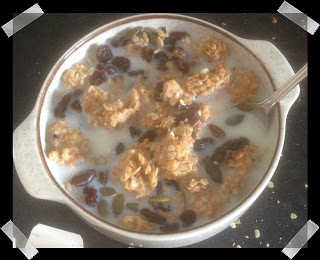 When I was a boy, my parents would often read me stories from The Railway Series. Save for nightmarish visions of poor old Henry being entombed in a tunnel as a punishment for his rain-related vanity (“That’ll learn him,” cackled the Fat Controller), the thing that’s stuck with me most about them is that proud old green engine needing special Welsh coal to be able to run properly. This is probably because I have my own special coal, you see, better known to most folk simply as “oats”.
When I was a boy, my parents would often read me stories from The Railway Series. Save for nightmarish visions of poor old Henry being entombed in a tunnel as a punishment for his rain-related vanity (“That’ll learn him,” cackled the Fat Controller), the thing that’s stuck with me most about them is that proud old green engine needing special Welsh coal to be able to run properly. This is probably because I have my own special coal, you see, better known to most folk simply as “oats”. And, fortunately, my favourite oat-based meal just happens to be preposterously cheap to make and wonderfully nutritious.

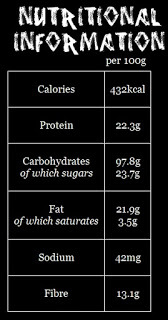
300g natural rolled oats [75p per 1kg, so 23p)
100g crunchy peanut butter [89p for 340g, so 26p]
80g clear honey [99p for 340g, so 23p]
100g raisins [£1.29 per 500g, so 26p]
70g crunchy trail seed mix [49p]
1tbsp (8g) cinnamon [41p per 37g, so 9p) TOTAL COST TO MAKE ONE BATCH (620G):
£0.23 + £0.26 + £0.23 + £0.26 + £0.49 + £0.09 = £1.56
TOTAL COST PER 100G: £0.25

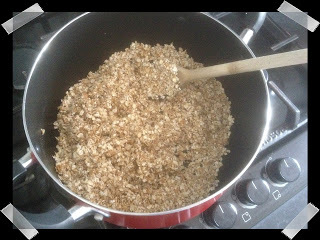 ONEPre-heat the oven to 180°c.
ONEPre-heat the oven to 180°c. TWOMix the peanut butter and honey in a pan and heat until warm. Be careful to ensure that the mixture does not burn or boil away – it just needs to be warm and well-mixed.
THREEPour the oats into the pan and stir until they are fully coated in the mixture.
FOURScrape the honey-nut oats into a baking tray and, using the reverse of your spoon, flatten them down to approximately 1cm thick.
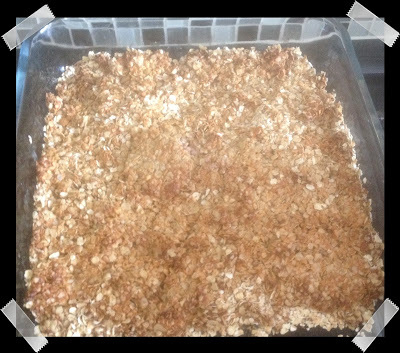 FIVEBake in the oven for 10-12 minutes.
FIVEBake in the oven for 10-12 minutes.SIXThis is the most crucial step. Remove the baking tray from the oven and, resisting the urge to smash it up and wolf it down straight away, set it down somewhere for at least 15 minutes.
SEVENTake a metal spoon and “dig” out approximately half the granola, placing it in a plastic cereal box.
EIGHTPour the raisins and seeds into the plastic cereal box too. Chopped-up brazil nuts also mix in well (but these aren’t accounted for in the nutritional information provided above).
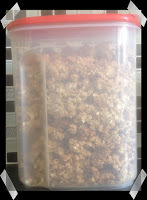
NINEClose its lid and then shake the cereal box.
TENUsing your metal spoon, “dig” out the remaining granola and place it in the plastic cereal box before repeating step nine vigorously.
ELEVENPour a 100g portion into a big bowl and, if you wish, add milk/soya milk. Enjoy!
Published on June 19, 2015 12:32
June 18, 2015
LEGO Castle Review | 6066 Camouflaged Outpost

 I wasn’t very old in 1987, when LEGO released this 211-piece set. Despite my tender age, though, I can clearly remember the trip to the toy shop with my dad, and the sheer excitement that I felt picking up a box almost as big as I was; a box teeming with more minifigures than I’d ever seen together in one set, let alone owned. Coming at the height of what my parents would retrospectively term my “Robin Hood Phase”, LEGO couldn’t have timed this release any better for me.
I wasn’t very old in 1987, when LEGO released this 211-piece set. Despite my tender age, though, I can clearly remember the trip to the toy shop with my dad, and the sheer excitement that I felt picking up a box almost as big as I was; a box teeming with more minifigures than I’d ever seen together in one set, let alone owned. Coming at the height of what my parents would retrospectively term my “Robin Hood Phase”, LEGO couldn’t have timed this release any better for me. But here’s the thing: it’s not really a “Robin Hood” set, strictly speaking - it’s a “Forestmen”, or “Forest People”, set. LEGO said, “The Forestmen are a merry band of skilled archers. They enjoy good food and good times,” and would often depict them as warring with the Crusaders in their catalogues and promotional material, even including a Forestman prisoner in a Crusaders set and an attacking Crusader in a Forestmen set, but they never officially acknowledged that these forest folk were intended to be Robin Hood and his band of outlaws. I find this odd, to say the least, as it’s not as if LEGO would have had to pay out any royalties for branding their Forestmen in a more marketable way.
But here’s the thing: it’s not really a “Robin Hood” set, strictly speaking - it’s a “Forestmen”, or “Forest People”, set. LEGO said, “The Forestmen are a merry band of skilled archers. They enjoy good food and good times,” and would often depict them as warring with the Crusaders in their catalogues and promotional material, even including a Forestman prisoner in a Crusaders set and an attacking Crusader in a Forestmen set, but they never officially acknowledged that these forest folk were intended to be Robin Hood and his band of outlaws. I find this odd, to say the least, as it’s not as if LEGO would have had to pay out any royalties for branding their Forestmen in a more marketable way.
 Ultimately it never mattered to me as a child – there was no arguing with me that the man in green was indeed Robin Hood, and with their long-established LEGO smiley faces, his men were certainly merry. Even the Forestmen’s stag emblem introduced in the next set called to mind Herne the Hunter, the shaman mystic who was the pagan Obi-Wan Kenobi to Michael Praed and Jason Connery’s Robins in the then-recent ITV series Robin of Sherwood. The green-clad Forestmen with their colourful tunics are, perhaps, a little basic by today’s standards, but there’s no denying their ineffaceable charm. Five of this set’s six figures come equipped with a lovely bow and arrow piece as well as quivers for their backs, and all of them proudly boast – cliché though it may be – the obligatory Robin Hood feather-topped caps. If LEGO ever revisit the Forestmen, I’d love to see a little more variety and detail in the minifigures – give us a friar and a Saracen; even a stubbly-chinned outlaw in a hood instead of cap. Forestmen designed to 2015 standards could be breathtaking.
Ultimately it never mattered to me as a child – there was no arguing with me that the man in green was indeed Robin Hood, and with their long-established LEGO smiley faces, his men were certainly merry. Even the Forestmen’s stag emblem introduced in the next set called to mind Herne the Hunter, the shaman mystic who was the pagan Obi-Wan Kenobi to Michael Praed and Jason Connery’s Robins in the then-recent ITV series Robin of Sherwood. The green-clad Forestmen with their colourful tunics are, perhaps, a little basic by today’s standards, but there’s no denying their ineffaceable charm. Five of this set’s six figures come equipped with a lovely bow and arrow piece as well as quivers for their backs, and all of them proudly boast – cliché though it may be – the obligatory Robin Hood feather-topped caps. If LEGO ever revisit the Forestmen, I’d love to see a little more variety and detail in the minifigures – give us a friar and a Saracen; even a stubbly-chinned outlaw in a hood instead of cap. Forestmen designed to 2015 standards could be breathtaking. However, even when judged by today’s lofty standards, the set itself holds up phenomenally well. Having rebuilt it just yesterday with the help of a surprisingly dexterous and patient pre-schooler, the first thing to strike me about it was its complexity. This woodland hideout, Robin Hood’s secret cave, or the Forestmen’s “Camouflaged Outpost”, if you will, boasts two entrances to its main cavern – a huge trapdoor at the front, large enough to let out a horse, as well as a pin-mounted black rock that conceals a discrete side entrance. Upstairs, meanwhile, there is a castle-like watchtower complete with overhanging greenery. The hinged set can also open out, allowing young players easy access to its interior, which includes a holstered axe and an empty treasure chest (proof, in my view, that the Forestmen were indeed Robin Hood and company – they’ve given away all their loot to the poor!)
However, even when judged by today’s lofty standards, the set itself holds up phenomenally well. Having rebuilt it just yesterday with the help of a surprisingly dexterous and patient pre-schooler, the first thing to strike me about it was its complexity. This woodland hideout, Robin Hood’s secret cave, or the Forestmen’s “Camouflaged Outpost”, if you will, boasts two entrances to its main cavern – a huge trapdoor at the front, large enough to let out a horse, as well as a pin-mounted black rock that conceals a discrete side entrance. Upstairs, meanwhile, there is a castle-like watchtower complete with overhanging greenery. The hinged set can also open out, allowing young players easy access to its interior, which includes a holstered axe and an empty treasure chest (proof, in my view, that the Forestmen were indeed Robin Hood and company – they’ve given away all their loot to the poor!) 
 The most remarkable thing about this set though, particularly in view of all its extruding greenery, is that it’s as tough as hell. Hold it by its smaller side, dangle it upside down, do what you will – the most that you’ll shake loose is a minifigure. That’s a real achievement for any set from any era.
The most remarkable thing about this set though, particularly in view of all its extruding greenery, is that it’s as tough as hell. Hold it by its smaller side, dangle it upside down, do what you will – the most that you’ll shake loose is a minifigure. That’s a real achievement for any set from any era.My only minor complaint about the outpost is that crowning it with a big, red flag seems somewhat at odds with its supposed “camouflage”, and the rampart on the observation platform feels a little too fortified for what is otherwise quite a credible outlaws’ den. Both issues are easily fixed, however: just break those damned bits off. That’s what I did back in ’87, and no doubt that’s what my daughter will be doing in about five minutes’ time...
Published on June 18, 2015 02:30
June 17, 2015
The Anti-Inflammatory Cookbook | New-tella Chocolate Hazelnut Spread
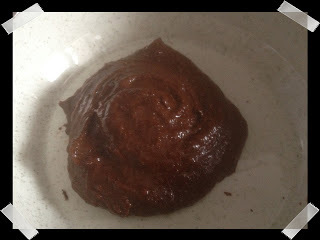 If you’re going to have a treat, why not make it one that’s a little healthier than most saturated fat-based, sugar-filled puds? Nutella® is abounding with healthy fats, heart-healthy antioxidants and even a bit more protein than the average bear, and whilst it’s still catastrophically calorific, it remains my weapon of choice when it comes to satisfying my sweet tooth.
If you’re going to have a treat, why not make it one that’s a little healthier than most saturated fat-based, sugar-filled puds? Nutella® is abounding with healthy fats, heart-healthy antioxidants and even a bit more protein than the average bear, and whilst it’s still catastrophically calorific, it remains my weapon of choice when it comes to satisfying my sweet tooth.However, as my dietary habits have tightened and I’m moving ever closer towards eating only whole foods, hazelnut spread as manufactured by Mr Ferrero’s minions is most definitely off the menu. If anything’s got ingredients listed on its packaging that I’m not familiar with, or that I feel are superfluous or artificial, then I’m not touching it.
Fortunately, this little concoction is even better than the real thing. Light on – if not free from, depending on what brand of dark chocolate you use – refined sugars and other artificial nasties, this deliciously dark and nutty spread is a much more natural way of sating your pudding stomach’s hunger.

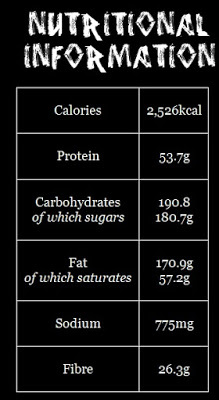 150g whole hazelnuts [£1.79 for 200g, so £1.34 for 150g]
150g whole hazelnuts [£1.79 for 200g, so £1.34 for 150g]205g evaporated milk [49p for 410g, so £25p for 205g. Aldi’s “Cowbelle” is not only the cheapest that I’ve come across, but also the most straightforward, containing only whole milk, stabiliser, and sodium phosphates. It’s also fortified with vitamin-D]
200g dark chocolate [At Aldi you can get a 200g bar of “Dairyfine” dark chocolate for just 85p. Like Cowbelle, it’s not only cheap but also simple, containing only cocoa butter, soya lecithin (presumably as an emulsifier) and sugar in addition to its 47% cocoa solids]
60g clear honey [99p for 340g, so 17p]
TOTAL COST TO MAKE ONE BATCH (515G): £1.34 + £0.25 + £0.85 + £0.17 = £2.61
TOTAL COST PER 100g: £0.51
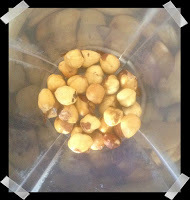 ONEPre-heat the oven to 180°c.
ONEPre-heat the oven to 180°c. TWOWeigh out 150g of hazelnuts onto a baking tray and roast in the oven for 10-12 minutes.
THREE (OPTIONAL)I can’t say that this makes any difference myself, but my wife insists that the product tastes better if the hazelnuts have their (now flaky) skin removed prior to the next step. Peel by hand and discard the skin.
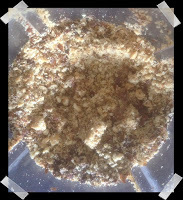 FOURPlace the hazelnuts into the blender and blend – for ages – until you have as fine a substance as your blender will produce.
FOURPlace the hazelnuts into the blender and blend – for ages – until you have as fine a substance as your blender will produce.FIVEMelt the chocolate and stir in the honey and condensed milk.
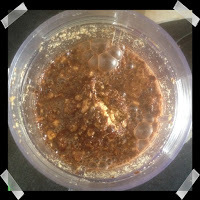 SIXPour the warm, milky chocolate honey into the blender, where your nuts await.
SIXPour the warm, milky chocolate honey into the blender, where your nuts await.SEVENBlend until the spread is as thick as you like it. The longer you blend the mixture, the more paste-like it will become. I find that it reaches the consistency of Nutella® within about a minute.
EIGHTPrepare to increase your body fat – massively.
Published on June 17, 2015 12:37
May 25, 2015
Fantastic Facts #1 | Right Next Door to Hell
 Particularly for grown-ups, it’s all too easy to get bogged down in the mundane. Some people go for months only thinking about only work targets and MOTs; big shops, sausages and SIM cards. I’m fortunate enough to have a three-year-old little girl whose endless energy is exceeded only by her curiosity about the world that we live in and all its awesome wonder. This bite-sized series is for her, as a little thank you for reminding me of it.
Particularly for grown-ups, it’s all too easy to get bogged down in the mundane. Some people go for months only thinking about only work targets and MOTs; big shops, sausages and SIM cards. I’m fortunate enough to have a three-year-old little girl whose endless energy is exceeded only by her curiosity about the world that we live in and all its awesome wonder. This bite-sized series is for her, as a little thank you for reminding me of it.About 67,108,000 miles from the sun spins a planet that seems to pride itself on being contrary. Once hailed on Earth as “Morning Star” and “Evening Star” due to its brightness at dawn and dusk, and later named after the Roman goddess of love for that same incandescent quality, Venus is in fact the terrestrial embodiment of Hell - the planet Earth as seen through a mirror, darkly.

At around 80% the size of our own blue orb, Venus is often referred to as Earth’s “twin” or “sister” planet, yet almost everything else about it is contradictory. You could visit Venus for a day, yet spend more than a year there as it travels around the Sun faster than it rotates on its own axis – and backwards, too. If you could stand on the planet’s blistering surface and somehow make out the dull, cloud-cloaked orange smudge that is the Sun, you’d see that it rises in the west and sets in the east, Venus’s “retrograde spin” setting it apart from every other planet in the Solar System.

But then, nobody is ever likely to be able to stand on Venus’s rocky landscape as, even if its sulphuric acid rain didn’t eat away their spacesuits and its deep-sea-like pressure didn’t give them the bends, its surface temperatures are hot enough to melt lead, and would therefore make short work of organic matter. Indeed, even Mercury, who spins a great deal closer to the Sun, can’t match Venus’s 480°c surface temperature, as it lacks the same thick, noxious clouds that trap the Sun’s heat inside the ultimate atmospheric greenhouse.
 Ironically though, it is this very damning atmosphere that reflects so much sunlight back into space, leaving Venus – for all its Hellish qualities – second only to the Moon in the dominance of Earth’s night sky.
Ironically though, it is this very damning atmosphere that reflects so much sunlight back into space, leaving Venus – for all its Hellish qualities – second only to the Moon in the dominance of Earth’s night sky.
Published on May 25, 2015 07:55
May 19, 2015
First-hand Fitness #4 | On Independence: Day 660
Sixty days ago I deleted my Runtastic and MyFitnessPal apps from my iPhone, and for the first time in almost two years went about my daily business without painstakingly logging every morsel of food eaten; every step taken; every bar lifted. I was curious as to whether prolonged use of these apps had instilled good behaviours, or actually left me reliant upon them forever more.
Thankfully, it’s the former. All that nutritional information has long-since been burnt into my brain; all those good practices have become part of my daily routine.
Since Day #601 I’ve gained 2lbs and increased my 10-rep bench press (a good yardstick for strength) by 10lbs, both of which are in keeping with my average rate of gain over the previous 600 days (they’re both actually a little better, no doubt thanks to my less strictly-controlled portions over the past sixty days).
And so, whilst I’ll continue to use MyFitnessPal for a strict fat-cutting week of protein and veg every couple of months, for the most part now I’ll be going it alone.
The MyFitnessPal app is free to download from the App Store. Since my 2012 review, it has been updated to encourage weight gain as well as weight loss, depending on your goal. Runtastic is also free to download from the App Store, with the more feature-packed Runtastic Pro costing you £3.99.
Thankfully, it’s the former. All that nutritional information has long-since been burnt into my brain; all those good practices have become part of my daily routine.
Since Day #601 I’ve gained 2lbs and increased my 10-rep bench press (a good yardstick for strength) by 10lbs, both of which are in keeping with my average rate of gain over the previous 600 days (they’re both actually a little better, no doubt thanks to my less strictly-controlled portions over the past sixty days).
And so, whilst I’ll continue to use MyFitnessPal for a strict fat-cutting week of protein and veg every couple of months, for the most part now I’ll be going it alone.
The MyFitnessPal app is free to download from the App Store. Since my 2012 review, it has been updated to encourage weight gain as well as weight loss, depending on your goal. Runtastic is also free to download from the App Store, with the more feature-packed Runtastic Pro costing you £3.99.
Published on May 19, 2015 21:20
May 8, 2015
The One-Listen Lowdown #3 | The Magic Whip by Blur
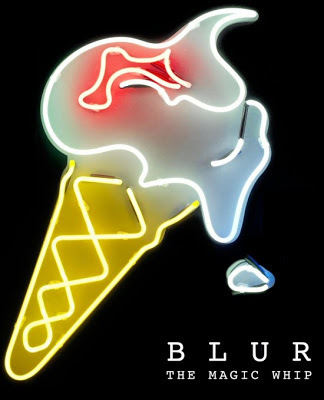 After so many years estranged in the wilderness, I was fretful about what the reformed Blur would sound like. Their 2012 interim single, “Under the Westway”, was a gentle, mellifluous piece that I felt boded well for a more substantial offering, but the unveiling of The Magic Whip’s cover gave me pause. Gone was the band/brand logo that had adorned most of their albums and singles. Gone were the spitfires, greyhounds, 4468 Mallards and flagons that I’d come to associate with their oh-so-English style. Hell, of Blur’s principal audience, only those who work in tattoo parlours are likely to be able to read the band’s name and the album’s title despite its repellent neon glow. All of this novelty, alas, evoked the sense of the troubled Think Tank over and above any of the group’s more acclaimed efforts.
After so many years estranged in the wilderness, I was fretful about what the reformed Blur would sound like. Their 2012 interim single, “Under the Westway”, was a gentle, mellifluous piece that I felt boded well for a more substantial offering, but the unveiling of The Magic Whip’s cover gave me pause. Gone was the band/brand logo that had adorned most of their albums and singles. Gone were the spitfires, greyhounds, 4468 Mallards and flagons that I’d come to associate with their oh-so-English style. Hell, of Blur’s principal audience, only those who work in tattoo parlours are likely to be able to read the band’s name and the album’s title despite its repellent neon glow. All of this novelty, alas, evoked the sense of the troubled Think Tank over and above any of the group’s more acclaimed efforts.My pause, however, would be brief. With my notepad in hand, fifty-two minutes flew past in a blur of nostalgia and enthusiasm.
 For starters, you couldn’t possibly get a more Blurry song than “Lonesome Street” to open a record. Harking back to the band’s Britpop heyday, Damon Albarn floats a flurry of “Oh-oh”s and “Oh no”s on top of one of Graham Coxon’s baggiest riffs in a long time, the sounds of contemporary city life discernable beneath the indie clamour in a way that instantly evokes “Parklife”. A quick shift of gears, and the haunting “New World Towers” recalls a different era altogether, whilst insidiously laying the foundations of a new one. Its sound may be a perfect fit for the band’s eponymous 1997 album, or perhaps even their seminal 13, but its lyrics are thoroughly 2015 – “Logging your name and pray…”
For starters, you couldn’t possibly get a more Blurry song than “Lonesome Street” to open a record. Harking back to the band’s Britpop heyday, Damon Albarn floats a flurry of “Oh-oh”s and “Oh no”s on top of one of Graham Coxon’s baggiest riffs in a long time, the sounds of contemporary city life discernable beneath the indie clamour in a way that instantly evokes “Parklife”. A quick shift of gears, and the haunting “New World Towers” recalls a different era altogether, whilst insidiously laying the foundations of a new one. Its sound may be a perfect fit for the band’s eponymous 1997 album, or perhaps even their seminal 13, but its lyrics are thoroughly 2015 – “Logging your name and pray…”  The album’s onomatopoeic lead single is a little disappointing by contrast. Unlike the first two tracks, I’ve already heard it a few times and don’t much care for it. Though I admire Albarn’s gall in writing a mainstream pop song that’s ostensibly about wanking, unfortunately it sounds eerily like its subject matter. De facto title track “Ice Cream Man” is even creepier, its electronic bounce belying what seems to be the tale of a paedo’s outing (“All the lantern men marching down ’til dawn. Morning come, he fall over…”) There’s something infectious about it, nonetheless; its hook is insidious.
The album’s onomatopoeic lead single is a little disappointing by contrast. Unlike the first two tracks, I’ve already heard it a few times and don’t much care for it. Though I admire Albarn’s gall in writing a mainstream pop song that’s ostensibly about wanking, unfortunately it sounds eerily like its subject matter. De facto title track “Ice Cream Man” is even creepier, its electronic bounce belying what seems to be the tale of a paedo’s outing (“All the lantern men marching down ’til dawn. Morning come, he fall over…”) There’s something infectious about it, nonetheless; its hook is insidious.“Thought I Was a Spaceman” is bleak in a striking, harmonious way, calling to mind favourite tracks of mine like “Strange News from Another Star” and “On the Way to the Club”. The band then turn briefly into Radiohead, delivering thirty seconds or so of music that if you close your eyes, you’d swear you were listening to Thom Yorke and company. But as soon as Albarn starts to croon, “I love the aspects of another city, the representatives are al-ri-i-i-ght. In circulation the snake and the tiger, waking up clean shaven in industrial li-i-i-ght,” they’re indubitably Blur once more, and at the height of their powers. A first-listen standout, “I Broadcast” would have been my pick for lead single.
 The Magic Whip only improves from there. “My Terracotta Heart” is the album’s buried treasure; a rare example of a heterosexual male lovesong - and one that finally draws a line under the Albarn / Coxon divide by combining what they each do best. Albarn sings of running out of heart and open road for his erstwhile brother as Coxon plays a gentle, haunting melody. It’s enough to bake any listener’s ceramic heart.
The Magic Whip only improves from there. “My Terracotta Heart” is the album’s buried treasure; a rare example of a heterosexual male lovesong - and one that finally draws a line under the Albarn / Coxon divide by combining what they each do best. Albarn sings of running out of heart and open road for his erstwhile brother as Coxon plays a gentle, haunting melody. It’s enough to bake any listener’s ceramic heart.Inspired by a hostage situation in a chocolate shop, “There Are Too Many of Us” is a wonderfully paranoid track that fuses the restless spirit of Modern Life is Rubbish with 13’s grand symphonic scale. Whilst you won’t find any sensible solution to the world’s overcrowding problem hidden in them, Albarn’s lyrics are spiky and distrustful (“Flashing lights advocate it, on the big screens everywhere…”), and, thanks in no small part to farmer/bassist Alex James, the delicately textured music has an epic feel to it that continues to build upon the emotional weight of the previous track.
“Ghost Ship” feels like a bit of a filler by contrast, sounding like so many other non-descript Blur album tracks that it almost feels like a deliberate gag. That’s not to do it down too much though; more leisurely than Leisure, it’s actually a very pleasant, easy listen. It’s followed by a stirring dirge for North Korea’s capital city, Pyongyang. Abounding with beautiful lyrics (“And the pink light that bathes the great leaders is fading, by the time your sun is rising there, out here it’s turning blue. The silver rockets coming and the cherry trees, Pyongyang, I’m leaving…”) and deft musical flourishes, it’s another prime example of how Blur have seamlessly picked up exactly where they should have left off at the end of the last century.
 “Lalalala lalalala lalalala lalala lalalala lalalalala…”
“Lalalala lalalala lalalala lalala lalalala lalalalala…” The Magic Whip’s penultimate track is probably destined to become its most popular, particularly at gigs. “Ong Ong” is a slow, lazy anthem that you can’t not sing along to. “I crawled out the harbour with recession behind, and now I’m feeling the love of you. So you better get a charge ’til I see you again, you’ll know just what to do…” It’s the perfect pop song for a sluggish, sizzling summer; another should-have-been single.
The Magic Whip’s penultimate track is probably destined to become its most popular, particularly at gigs. “Ong Ong” is a slow, lazy anthem that you can’t not sing along to. “I crawled out the harbour with recession behind, and now I’m feeling the love of you. So you better get a charge ’til I see you again, you’ll know just what to do…” It’s the perfect pop song for a sluggish, sizzling summer; another should-have-been single.True to form, Blur leave us with a crushing low in the form of “Mirrorball”. A contemporary answer to “This is a Low” with all the devastating immensity of “Battery in Your Leg”, The Magic Whip’s final crack puts an emotive exclamation on what has to be considered a triumphant comeback.
 “So before you log out, hold close to me…”
“So before you log out, hold close to me…” This summer, as ice creams drip, fireworks explode and MPs are whipped in, The Magic Whip is sure to be playing away in the background everywhere, spreading unease as Blur’s ’90s “modern life is rubbish” philosophy evolves into “modern life is… wrong.” And with the Tories back in charge of the UK, this time unhindered, it’s sure to get a whole lot wronger around here soon.
This summer, as ice creams drip, fireworks explode and MPs are whipped in, The Magic Whip is sure to be playing away in the background everywhere, spreading unease as Blur’s ’90s “modern life is rubbish” philosophy evolves into “modern life is… wrong.” And with the Tories back in charge of the UK, this time unhindered, it’s sure to get a whole lot wronger around here soon.The Magic Whip is available to download from iTunes for £9.99 or Amazon’s MP3 store for £9.89. Ten pence more will get you the CD too, but if you go down that route you’ll have to either spend another £11.01 to qualify for free delivery or stump up however much Amazon charge for postage and packing these days.
Published on May 08, 2015 12:14
E.G. Wolverson's Blog
- E.G. Wolverson's profile
- 52 followers
E.G. Wolverson isn't a Goodreads Author
(yet),
but they
do have a blog,
so here are some recent posts imported from
their feed.



